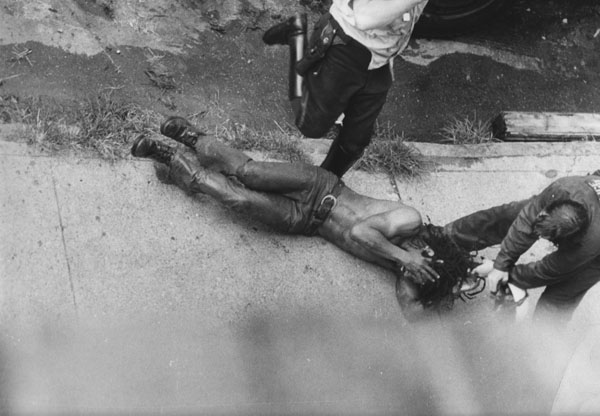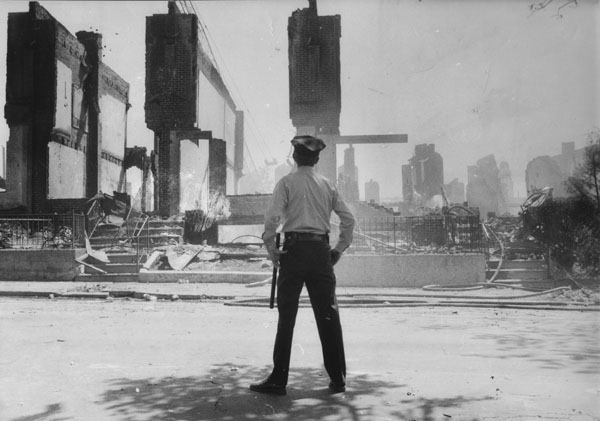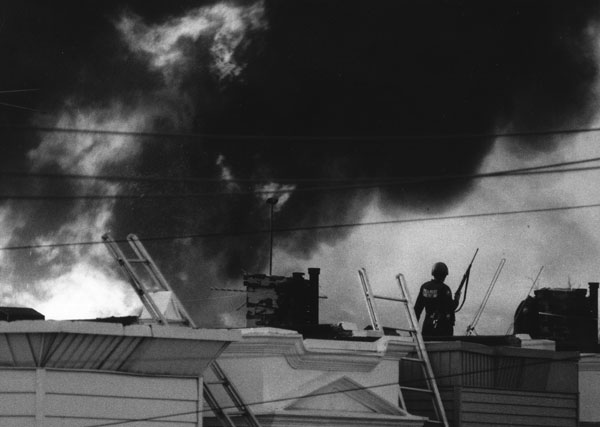To begin with Nicolas Rapold in the New York Times, “Films Beget Films is the title of Jay Leyda’s 1964 book about compilation films: new works stitched together out of old footage. In the case of Let the Fire Burn, it’s video that begets a riveting chronicle of the radical group Move’s clash with Philadelphia authorities and a catastrophic siege of its headquarters in 1985. Seamlessly fashioned from television news footage, public hearings and other sources, the movie relives an incredible chapter in American history.”
Introducing her interview with filmmaker Jason Osder for (ahem) BOMB Magazine, Pamela Cohn sketches the background to the tragedy: “Over a decade of conflict and antagonism between the Philadelphia police force and a group of African American revolutionaries known as MOVE, culminated with an epic tragedy on May 13, 1985. MOVE members had taken over a multi-story row house in a lower-middle class, mostly Black, West Philadelphia neighborhood where several members—men, women and children—were living off the grid together as an extended family. On that day, after an hours-long extensive gunfight and stand off—and after evacuating the neighborhood—police commissioner Greg Sambor authorized a bomb to be dropped from a helicopter on the MOVE compound. The row house caught fire, and following a directive from Mayor Wilson Goode to ‘let the fire burn,’ all the residents trapped inside the house—except for one little boy and one woman—were killed.” That boy, by the way, Michael Ward, died on Friday, September 20.
David Fear in Time Out New York: “‘It’s not a cult, it’s an organization,’ claimed MOVE leader John Africa… Social workers and neighbors of this ’70s African-American collective would describe them as a cult due to their unusual parenting methods and insular groupthink attitude; MOVE members would say that their vegan, back-to-the-land lifestyles were a protest against technology and a way to return to their roots…. What Osder yields from these patchworks, sans 20/20-hindsight commentary, feels closer to journalism than the usual cinematic editorials that have become a default mode for many historical documentaries…. [H]e’s produced a first-rate piece of forensic filmmaking.”
Bill Weber in Slant: “Osder anchors the narrative in a pair of legal proceedings: the hearings of a commission appointed to investigate the events, and the deposition of 13-year-old Michael Ward… The immediacy of the testimony, halting or furious, and the fresh psychological wounds of the witnesses justify Osder’s decision to forego original interviews; while they’re edited into and contextualized by news clips, there’s blunt force in the anger of two MOVE women insulting their interrogators, monotonal policemen skating around self-incrimination, and young Michael, burn scars visible on his face, recounting the spartan life of children in the communal home and his precarious hours of refuge during the May 13 shootout and inferno. The testimony is uncolored by nostalgia, haziness, or the studied quality often acquired from years of retrospection; self-revelation comes spontaneously.”
More from Diana Clarke (Voice), Tasha Robinson (Dissolve), and, at the L, Henry Stewart, who’s clearly taken with the film and writes a vibrant review—but I want to clip this scene-setter from the top: “It’s hard for people who weren’t there to understand—or even for those who were to remember—just how weird things got in the years from Nixon to Reagan, how violent the country became not (just) in terms of street muggings but of large-scale destruction. When a bomb exploded in Boston this spring, the post-9/11 populace was shocked and disturbed, not only by the loss of life and limb but also by the spectacle; but did you know ‘from January 1969 to October 1970, there were about 370 bombings—most of them minor—in New York, an average of more than one every other day,’ as the Times reported in 2009? In the 80s, token booths were frequently set on fire with the clerks still inside; in the 70s, neighborhoods were essentially burned to the ground.”
Then, via Critics Round Up, interviews with Osder that ran when Let the Fire Burn screened at the Tribeca Film Festival this spring: Nicolas Rapold (Film Comment) and Vadim Rizov (Filmmaker). Let the Fire Burn opens today at Film Forum in New York. For more cities and dates, click right here.
Updates, 10/3: “The sophisticated storytelling in Let the Fire Burn doesn’t idealize MOVE, nor does it villainize the authorities, but the evidence against the state is damning,” writes Susanna Locascio at Hammer to Nail. “Through its tragic tale of an historical event, Let the Fire Burn ignites an important conversation about race relations in America, but also about the legitimate use of power, especially by the state against what it has deemed ‘terrorist’ activity.”
“Osder has made a historical documentary that’s astonishingly in the present tense,” agrees New York‘s David Edelstein. “Osder shows that there are truths out there waiting to be found—that footage already shot can make history in all its terrible finality breathe.”
“The story is brought to volcanic, penetrating life by Osder, a professor at George Washington University and one of Filmmaker‘s ’25 New Faces’ of 2013,” writes Brandon Harris, introducing his interview with the director.
Updates, 10/5: “Welcome to America, people, where the past, as Faulkner famously observed, is not even past,” writes Salon‘s Andrew O’Hehir. This film’s “wrenching story of hope and hatred from 28 years ago hit me especially hard in this year of white rage and white derangement, the year of George Zimmerman and Paula Deen and a government shutdown engineered entirely by a small group of congressmen who represent a lily-white, neo-Confederate nation within a nation. Half a century of evil and insidious racial politicking has brought us to this point of right-wing wish-fulfillment apocalypse, along with the profoundly racist congressional gerrymander of 2010 and the creeping fear among many white Americans that the country they thought they understood–thought they owned—has been yanked out from under their feet.”
Slate‘s Emily Bazelon, whose father, Richard Bazelon, was chair of the Redevelopment Authority of Philadelphia during the period depicted by Let the Fire Burn, tells the story of what happened to the neighborhood in the years that followed.
Updates, 10/25: Let the Fire Burn “not only tells a story but also asks its viewers to reflect on how history is documented while in progress,” writes Michael Sicinski for the Nashville Scene. “MOVE was anti-technology, and so aside from a few brief films shot by outsiders sympathetic to the group, they were ‘framed’ by the media complex of the dominant culture they struggled so hard to resist. By highlighting this, Osder has made [a] difficult film—one that implicitly critiques virtually every other act of contemporary documentation.”
“In an era where jittery YouTube videos of seemingly racially-motivated police abuses have trumped mainstream media coverage of most urban issues, Let the Fire Burn is a haunting cultural corrective,” writes Robert Greene for Sight & Sound. “Osder uses his footage to transform the characters onscreen from ghosts of a forgotten past to flesh-and-blood human beings, struggling, living and dying in the here and now. This is an unmistakably political film about the way in which moral abstraction and insipid institutional logic can lead directly to heartbreaking tragedy.”
Update, 12/6: “What we see in Let the Fire Burn,” writes Charles Mudede in the Stranger, “is the smoothness of a process that has two main components—the media and the justice system—and these key features: It appears to be democratic, have no center, and be disconnected from history. This process, however, has inputs that have been precisely shaped by historical events and class positions within a hierarchical order of social power: what kind of person should be in the police department (a working-class white male), what kind of person should be in jail (a poor black male), who should moderate a commission (an educated white male), who should represent the black community (an educated black man), and so on. Although no one is directing this process, the right inputs still produce predictable outcomes: At the end of the commission on the incident, white officers are vindicated and the black radicals who are not dead are serving long sentences.”
For news and tips throughout the day every day, follow @KeyframeDaily on Twitter and/or the RSS feed. Get Keyframe Daily in your inbox by signing in at fandor.com/daily.






